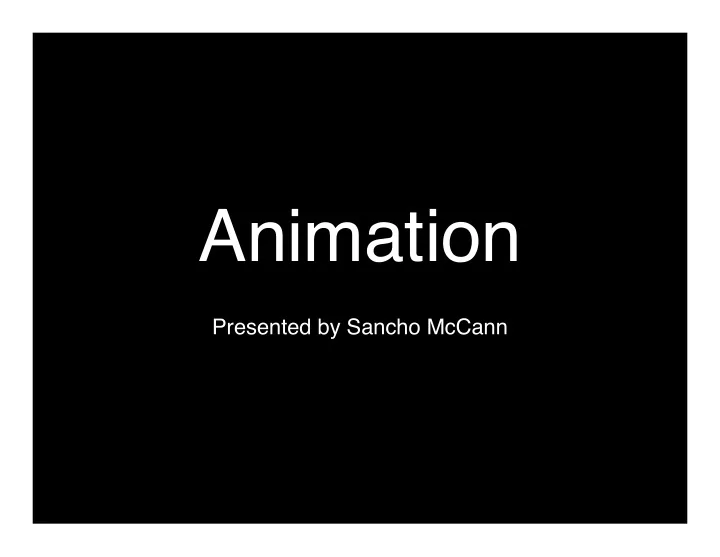

Animation Presented by Sancho McCann
Animation • Is animation useful? • Why? • Principles of animation • Principles applied
Animation: can it facilitate? • Does animation help the understanding of changes over time? • A picture is worth 1000 words; is a 100 frame animation even worth 100 stills? • “Yes?” - the congruence principle • “No?” - the apprehension principle
Congruence Principle • A useful graphic is congruent to the structure and content of the internal representation. • Either match a users internal representation or, • Force a useful internal representation.
Wood, D. (1992). The Power of Maps.
Wood, D. (1992). The Power of Maps.
Congruence Principle Violated • 3D does not improve 90 congruence; 80 70 60 50 • 3D does not improve 40 East performance, speed, 30 accuracy, or 20 memory. 10 0 1st 2nd 3rd 4th Qtr Qtr Qtr Qtr
Congruence Principle Applied
Congruence in Static Graphics US Patent 223898 http://www.math.ubc.ca/~cass/Euclid/papyrus /papyrus.html http://www.classicmaps.com • Using space to portray space has been widely successful for millennia.
Congruence in Animations
Does Animation Facilitate? • How could we compare the effectiveness of an animated presentation against a static presentation?
Rieber ’ s Animated Graphic • Block and ball moved at different speeds Rieber, L. P. (1991a). Animation, incidental learning, and continuing motivation. Journal of Educational Psychology , 83, 318–328.
Rieber ’ s Static Graphic • No information about speeds of the objects was presented, only arrows to indicate direction of motion. Rieber, L. P. (1991a). Animation, incidental learning, and continuing motivation. Journal of Educational Psychology , 83, 318–328.
Rieber ’ s Post Test Rieber, L. P. (1991a). Animation, incidental learning, and continuing motivation. Journal of Educational Psychology , 83, 318–328.
Does Animation Facilitate? • Many of the studies have confounding variables on the results of the test: – The animation was interactive – The animation showed more information • Comparison on equal ground: – Tutorials based on animation are actually not remembered well
Palmiter, S. & Elkerton, J. (1993). Animated demonstrations for learning procedural computer-based tasks. Human–Computer Interaction , 8, 193–216.
Why Not? • The apprehension principle states that the external representation must be readily and accurately perceived and comprehended. • Animation violates this principle!
Why Not? • Minds are not easily forced to hold a continuous representation. • Animations are comprehended discretely. • Different viewers will take away different elements from an animation. • Animation is fleeting.
Advice • Useful when timing is important • Realism is not important, your information is – Slow down animations at critical phases – Annotate, highlight, direct attention – Eliminate unnecessary information • Allow interaction
The Music Animation Machine
Animation useful for timing?
Interactive Animation • Richard Lowe. User-Controllable Animated Diagrams: The Solution for Learning Dynamic Content?
Interactive Animation • Animation is not fleeting • Animation is not overwhelming • View animation at any speed • Extract fine and coarse grained information
Interactive Animation • Given: – 28 frame user-controllable weather map representing a 7 day period – Another “Original” weather map • Task: – Use patterns learned in the animation to predict the weather map 24 hours after the “Original”
Interactive Animation Richard Lowe. User-controlled animated diagrams: the solution for learning dynamic content?. In Lecture Notes in Computer Science - Diagrammatic Representation and Inference. Springer-Verlag, 2004.
Interactive Animation • Animation only used for an overview • Novice users did not use animation to learn temporal relations between features; they didn ’ t know to look! • The animation degraded to a flip-book of images
Animated Interaction • Animation does aid understanding of interactive and dynamic changes to an interface.
Animated Interaction
Principles of Animation • John Lasseter. Principles of Traditional Animation Applied to 3D computer Animation. 1987.
Principles of Animation • From classes promoted by Walt Disney in the 1930s, The 11 Principles arose
Squash and Stretch
Timing
Anticipation
Staging
Staging
Slow-In Slow-Out
Arcs
Exaggeration
Appeal
Three Other Principles • Follow-through and Overlapping Action • Straight Ahead or Pose-to-Pose • Secondary Action
Principles Applied
An Application • David Carr and Matja_ Kljun. The Effect of Animated Transitions on User Navigation in 3d Tree-Maps. Proceedings of the 9th Intl. Conference on Information Visualization (IV 2005).
An Application • How is staging applied? • How is anticipation applied? • What other principles are applied? • What principles could have been applied?
Discussion • Animation did allow for different types of navigation - short-cuts • The short-cuts were not effective - users got lost.
Summary • Animation is deceivingly attractive • Interactive animation might help • Animated interaction does help
Papers • Barbara Tversky, Julie Bauer Morrison and Mireille Betrancourt. Animation: can it facilitate?. In International Journal of Human- Computer Studies, 57 . Elsevier Science Ltd, 2004. • Richard Lowe. User-controlled animated diagrams: the solution for learning dynamic content?. In Lecture Notes in Computer Science - Diagrammatic Representation and Inference. Springer-Verlag, 2004
Papers • John Lasseter. Principles of traditional animation applied to 3D computer animation. In ACM Journal of Computer Graphics, 21 - 4, July 1987. • Bladh, T., Carr, D. A., and Kljun, M. 2005. The Effect of Animated Transitions on User Navigation in 3D Tree-Maps. In Proceedings of the Ninth international Conference on information Visualisation (Iv'05) - Volume 00 (July 06 - 08, 2005). IV. IEEE Computer Society, Washington, DC, 297-305.
Recommend
More recommend